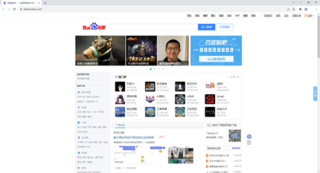Warnock's dilemma, named for its originator Bryan Warnock, is the problem of interpreting a lack of response to a posting in a virtual community. [1] The term originally referred to mailing list discussions, but has been applied to Usenet posts, blogs, web forums, and online content in general. [2] The dilemma arises because a lack of response does not necessarily imply that no one is interested in the topic, but could also mean for example that readers find the content to be exceptionally good (leaving nothing for commenters to add). [2]
On many internet forums, only around one percent of users create new posts, while nine percent reply and 90 percent are lurkers that do not contribute to the discussion. [3] When no users reply, the original poster has no way of knowing what lurkers think of their contribution.
Warnock's dilemma leads to online writers and publishers adopting more provocative writing strategies in order to ensure that they will get a response. [4] [5] However, this can also lead publishers to avoid producing the kind of content that might fail to generate comments due to its high quality. [6] This problem arises particularly with sites that focus on viral content, such as BuzzFeed and Huffington Post . [6]
The problem with no response is that there are five possible interpretations:
- The post is correct, well-written information that needs no follow-up commentary. There's nothing more to say except "Yeah, what he said."
- The post is complete and utter nonsense, and no one wants to waste the energy or bandwidth to even point this out.
- No one read the post, for whatever reason.
- No one understood the post, but won't ask for clarification, for whatever reason.
- No one cares about the post, for whatever reason.
— Bryan C. Warnock, [7]
Since Warnock's original description of the dilemma in August 2000, the expression has become used in the Perl world. [8] [ dubious – discuss ]

Electronic mail is a method of transmitting and receiving messages using electronic devices. It was conceived in the late–20th century as the digital version of, or counterpart to, mail. Email is a ubiquitous and very widely used communication medium; in current use, an email address is often treated as a basic and necessary part of many processes in business, commerce, government, education, entertainment, and other spheres of daily life in most countries.
Flaming, also known as roasting, is the act of posting insults, often including profanity or other offensive language, on the internet. Flaming is distinct from trolling, which is the act of someone causing discord online or in person. Flaming emerges from the anonymity that Internet forums provide for users and which allow them to act more aggressively. Anonymity can lead to disinhibition, which results in the swearing, offensive, and hostile language characteristic of flaming. Lack of social cues, less accountability of face-to-face communications, textual mediation and deindividualization are also likely factors. Deliberate flaming is carried out by individuals known as flamers, which are specifically motivated to incite flaming. These users specialize in flaming and target specific aspects of a controversial conversation.
LiveJournal, stylised as LiVEJOURNAL, is a Russian-owned social networking service where users can keep a blog, journal, or diary. American programmer Brad Fitzpatrick started LiveJournal on April 15, 1999, as a way of keeping his high school friends updated on his activities. In January 2005, American blogging software company Six Apart purchased Danga Interactive, the company that operated LiveJournal, from Fitzpatrick.
RTFM is an initialism and internet slang for the expression "read the fucking manual" – typically used to reply to a basic question where the answer is easily found in the documentation, user guide, owner's manual, man page, online help, internet forum, software documentation or FAQ.
The term netizen is a portmanteau of the English words internet and citizen, as in a "citizen of the net" or "net citizen". It describes a person actively involved in online communities or the Internet in general.

An online community, also called an internet community or web community, is a community whose members interact with each other primarily via the Internet. Members of the community usually share common interests. For many, online communities may feel like home, consisting of a "family of invisible friends". Additionally, these "friends" can be connected through gaming communities and gaming companies. Those who wish to be a part of an online community usually have to become a member via a specific site and thereby gain access to specific content or links.
Social software, also known as social apps or social platform includes communications and interactive tools that are often based on the Internet. Communication tools typically handle capturing, storing and presenting communication, usually written but increasingly including audio and video as well. Interactive tools handle mediated interactions between a pair or group of users. They focus on establishing and maintaining a connection among users, facilitating the mechanics of conversation and talk. Social software generally refers to software that makes collaborative behaviour, the organisation and moulding of communities, self-expression, social interaction and feedback possible for individuals. Another element of the existing definition of social software is that it allows for the structured mediation of opinion between people, in a centralized or self-regulating manner. The most improved area for social software is that Web 2.0 applications can all promote co-operation between people and the creation of online communities more than ever before. The opportunities offered by social software are instant connections and opportunities to learn. An additional defining feature of social software is that apart from interaction and collaboration, it aggregates the collective behaviour of its users, allowing not only crowds to learn from an individual but individuals to learn from the crowds as well. Hence, the interactions enabled by social software can be one-to-one, one-to-many, or many-to-many.

An Internet forum, or message board, is an online discussion site where people can hold conversations in the form of posted messages. They differ from chat rooms in that messages are often longer than one line of text, and are at least temporarily archived. Also, depending on the access level of a user or the forum set-up, a posted message might need to be approved by a moderator before it becomes publicly visible.
When a message is replied to in e-mail, Internet forums, or Usenet, the original can often be included, or "quoted", in a variety of different posting styles.
Open-source journalism, a close cousin to citizen journalism or participatory journalism, is a term coined in the title of a 1999 article by Andrew Leonard of Salon.com. Although the term was not actually used in the body text of Leonard's article, the headline encapsulated a collaboration between users of the internet technology blog Slashdot and a writer for Jane's Intelligence Review. The writer, Johan J. Ingles-le Nobel, had solicited feedback on a story about cyberterrorism from Slashdot readers, and then re-wrote his story based on that feedback and compensated the Slashdot writers whose information and words he used.
In Internet culture, a lurker is typically a member of an online community who observes, but does not participate by posting. The exact definition depends on context. Lurkers make up a large proportion of all users in online communities. Lurking allows users to learn the conventions of an online community before they participate, improving their socialization when they eventually "de-lurk". However, a lack of social contact while lurking sometimes causes loneliness or apathy among lurkers.

User-generated content (UGC), alternatively known as user-created content (UCC), is generally any form of content, such as images, videos, audio, text, testimonials, and software, that has been posted by users on online content aggregation platforms such as social media, discussion forums and wikis. It is a product consumers create to disseminate information about online products or the firms that market them.

Usenet, USENET, or, "in full", User's Network, is a worldwide distributed discussion system available on computers. It was developed from the general-purpose Unix-to-Unix Copy (UUCP) dial-up network architecture. Tom Truscott and Jim Ellis conceived the idea in 1979, and it was established in 1980. Users read and post messages to one or more topic categories, known as newsgroups. Usenet resembles a bulletin board system (BBS) in many respects and is the precursor to the Internet forums that have become widely used. Discussions are threaded, as with web forums and BBSes, though posts are stored on the server sequentially.

In Internet culture, the 1% rule is a general rule of thumb pertaining to participation in an Internet community, stating that only 1% of the users of a website actively create new content, while the other 99% of the participants only lurk. Variants include the 1–9–90 rule, which states that in a collaborative website such as a wiki, 90% of the participants of a community only consume content, 9% of the participants change or update content, and 1% of the participants add content.

Baidu Tieba is a Chinese online forum hosted by the Chinese web services company Baidu. Baidu Tieba was established on December 3, 2003 as an online community that heavily integrates Baidu's search engine. Users may search for a topic of interest forum known as a "bar" which will then be created if it does not exist already. Baidu Tieba accumulated 45 million monthly active users as of December 2021, and the number of its total registered users reached 1.5 billion. As of June 6, 2021, Baidu Tieba has 23,254,173 communities.
Online participation is used to describe the interaction between users and online communities on the web. Online communities often involve members to provide content to the website or contribute in some way. Examples of such include wikis, blogs, online multiplayer games, and other types of social platforms. Online participation is currently a heavily researched field. It provides insight into fields such as web design, online marketing, crowdsourcing, and many areas of psychology. Some subcategories that fall under online participation are: commitment to online communities, coordination and interaction, and member recruitment.
Reblogging is the mechanism in blogging which allows users to repost the content of another user's post with an indication that the source of the post is another user.

r/The_Donald was a subreddit where participants created discussions and Internet memes in support of U.S. president Donald Trump. Initially created in June 2015 following the announcement of Trump's presidential campaign, the community grew to over 790,000 subscribers who described themselves as "Patriots". The community was banned in June 2020 for violating Reddit rules on harassment and targeting. It was ranked as one of the most active communities on Reddit.

Gab is an American alt-tech microblogging and social networking service known for its far-right userbase. Widely described as a haven for neo-Nazis, racists, white supremacists, white nationalists, antisemites, the alt-right, supporters of Donald Trump, conservatives, right-libertarians, and believers in conspiracy theories such as QAnon, Gab has attracted users and groups who have been banned from other social media platforms and users seeking alternatives to mainstream social media platforms. Founded in 2016 and launched publicly in May 2017, Gab claims to promote free speech, individual liberty, the "free flow of information online", and Christian values. Researchers and journalists have characterized these assertions as an obfuscation of its extremist ecosystem. Antisemitism is prominent in the site's content and the company itself has engaged in antisemitic commentary. Gab CEO Andrew Torba has promoted the white genocide conspiracy theory. Gab is based in Pennsylvania.
The comments section is a feature on most online blogs, news websites, and other websites in which the publishers invite the audience to comment on the published content. This is a continuation of the older practice of publishing letters to the editor. Despite this, comments sections can be used for more discussion between readers.